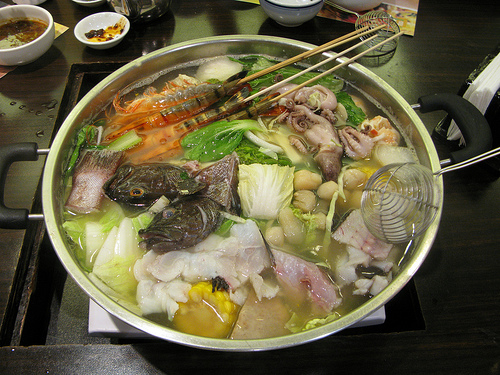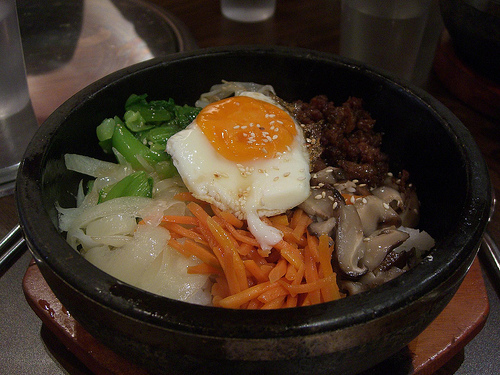“One of the very nicest things about life is the way we must regularly stop whatever it is we are doing and devote our attention to eating.” ~Luciano Pavarotti and William Wright, Pavarotti, My Own Story
One of the most frequent questions I have been asked since I returned from Korea last week is: “What was the food like?” Well, that question does not lend itself to an easy answer. In almost every culture, food is top priority. People are proud and protective of their food customs, since they are so closely intertwined with the culture’s heritage and lifestyle and South Korea is no different. Having never eaten Korean food before the trip, I wasn’t quite sure what to expect. Our hosts offered us a wide variety of traditional ethnic foods so we were really able to experience authentic Korean cuisine that was unlike anything I had ever experienced before.
Each eating experience was truly an adventure, particularly given that the customs associated with meals were almost as foreign as the food itself. For instance, when in Korea, one drinks and eats with only the right hand. Drinks are poured by the person seated nearest to you; you do not refill your own drink. When accepting a refill, it is customary to hold the cup with both hands and then fill the cup of the person who just filled yours.
Elders are highly respected in Korean culture and no one eats until the eldest person at the table begins eating. Similarly, unless you are the eldest person at the table, you must turn away from the table when drinking anything other than water.
Sound confusing? It is.

The strangest dish that I ate while in Korea, by far, was shabu-shabu. Shabu-shabu is a type of hot pot cooking, whereby meat, seafood and vegetables are cooked in boiling broth at the table in front of you. The art of cooking food in the hot pot is not what made the meal so memorable, however. It was the live – yes, I said live – octopus that was brought out to each person to place in the hot pot. The tiny creature clung to the side of the bowl with its sticky tentacles before the waiter pried him free and placed it in the boiling liquid. After a few minutes, the tentacles were snipped off and eaten. About twenty minutes later, the octopus body was cut, releasing its black ink onto the plate. I made a deliberate effort to eat most things, despite any initial aversions, but this was one that I just couldn’t stomach (no pun intended). Tentacles, yes. Inky octopus stomach, no thank you.
The most traditional food we ate was kimchi. Kimchi is a side dish made with fermented cabbage and other vegetables that are seasoned with chili paste and other spices. There are hundreds of varieties of kimchi and it is eaten at almost every meal. It seems to be a largely acquired taste, yet I was rather indifferent to the dish.
The most useful dish in Korean gastronomy is the Samgyetang, which is a chicken ginseng soup. The dish is commonly eaten in late spring and early summer in order to provide the stamina to endure the heat of the summer months. A half of a chicken is in each bowl of soup, bones and all, making eating a bit slow and difficult to east. The rice at the bottom of the bowl, however, was sticky, sweet, and absolutely delightful.

The tastiest drink is soju, which is a rice wine that tastes similar to vodka but, with an alcohol content of 19%, is bit less potent. As I mentioned, the customs when it comes to drinking can be a bit overwhelming. One must remember to keep tabs on the needs of those around them and refill a person’s cup if it is less than half full. When receiving a refill, one must hold the cup with two hands out of respect. And, unless one is the eldest person at the table, he or she must turn away slightly when taking a drink. Despite my confusion with the customs, however, there is something very admirable about a culture that requires you to focus more on the needs of others than your own.
The tastiest dishes I ate while in Korea were bibimbap and pajeon. Bibimbap is a rice dish made topped with sautéed vegetables, chili paste, and a fried egg. Panjeonis a thick doughy scallion pancake frequently served in a cast iron skillet.

So, what was the food like? Well, this past week I have found myself craving bibimbap and the sticky ginseng-laced rice at the bottom of the bowl of Samgyetang. And I am eager to experiment with new ways to use the jars and bottles of chili paste that I brought home.
But, I must admit, I’m still mourning the death of that octopus.
Author’s Note: My post on green growth in South Korea was recently published at Urban Times. You can check it out here. Obviously my trip to South Korea provided a great deal of blog fodder.

4 Comments
Oh my gosh, that octopus. Like you I would have had to draw the line. I’ve eaten octopus before and I love it, but I’ve never watched it die in front of me, attempting to cling to life. Same is true of anything once alive that I eat. Geez, I need to become a vegetarian. Changing the subject, I make kimchi. Fermented cabbage and whatever you add to it is probably one of the healthiest foods you can eat. It cleans out the bad bacteria of your digestive system replacing it with good bacteria. It’s bubbling and alive with vitamins and minerals. I love it. Moving on again, I love Asian food in general, but they do offer up some strange to the Western palate stuff. I tried most everything at least once when I traveled through Southeast Asia. Though when someone offered me a fried cricket, I said no thank you. Great posts of your trip. I thoroughly enjoyed them.
Thanks. I’m glad that you enjoyed reading the posts. I think I would have had to say “no thank you” to the cricket as well. I hear you on latent vegetarianism.
Bibimbap, yes! A staple in our house. If you have a sous chef to prepare all the veggies, that helps. So tasy and delish. I think it has something to do with the mixture of flavors and textures. Crunchy vegetables, sticky rice, oozy egg. Mmmmmm! I have two great recipes if you want them!
I would LOVE to get your recipes!